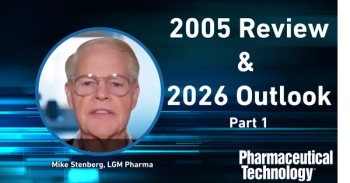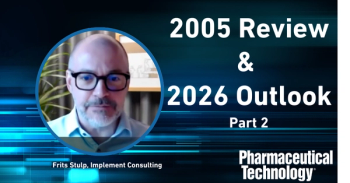
- Pharmaceutical Technology-07-02-2017
- Volume 41
- Issue 7
Process Validation Evolution—The Lifecycle Approach
FDA’s process validation guidance has evolved and the current lifecycle approach has profoundly influenced validation practice.
FDA issued the guidance document Process Validation: General Principles and Practices, which formalized the lifecycle approach to process validation in January 2011 (1). This document represented a significant evolution of thinking on validation, updated FDA expectations for process validation, and integrated other contemporary pharmaceutical manufacturing principles. The lifecycle approach to validation described activities categorized in three integrated stages that encompass the entire product continuum from development through commercial product discontinuation. The following discussion briefly describes events leading to development of the lifecycle approach, and proposes some future applications of this approach.
Validation evolution: Origin to future
The origins of validation may be traced to the Elixir Sulfanilamide tragedy in 1937, when an improperly prepared medicine caused more than 100 deaths. This tragedy caused passage of the 1938 Food, Drug, and Cosmetic Act (FD&C Act), which granted FDA more jurisdiction over drug products. The FD&C Act authorized facility inspections; later an amendment allowed inspectors to examine records connected with manufactured drugs.
cGMPs. The next major timeline event specifically involving validation occurred in the 1960s and 1970s leading to publishing of the Current Good Manufacturing Practices in 1978 (2). While the term “validation” was freely mentioned in FDA discussions during this timeframe, definition, expectations, or applications were not explained. Preliminary discussions introduced concepts such as product design, protocols, acceptance criteria, qualification, documentation, and statistics--fundamentals of validation. A GMP for large volume parenterals was proposed that focused on sterilization, water systems, HVAC, and other systems to be prospectively demonstrated to operate as intended. Efforts then shifted to non-aseptic products and processes. Industry discussions and workshops helped to further develop validation thinking. Retrospective and concurrent validation approaches evolved, and the “three-lot” concept was born. A definition of validation was finally proposed that focused on the essence of validation: Documented evidence that the system does what it is supposed to do. The validation concept was definitely evolving.
The first FDA validation guidance. FDA issued Guideline on General Principles of Process Validation in 1987 (3). While this guidance and subsequent related documents mentioned the importance of product development and ongoing commercial post-validation manufacturing, the emphasis of validation was on the three documented validation conformance lots. The 1987 guidance briefly mentions “... adequate product and process design ...”, “... quality, safety, and effectiveness must be designed and built into the product...”, and “During the research and development (R&D) phase, the desired product should be carefully defined in terms of its characteristics, such as physical, chemical, electrical, and performance characteristics.” In addition to discussing actual validation protocols, the guidance mentions several post-validation considerations as follows: “...quality assurance system in place which requires revalidation whenever there are changes in packaging, formulation, equipment, or processes which could impact product effectiveness or product characteristics, and whenever there are changes in product characteristics.” Also, “The quality assurance procedures should establish the circumstances under which revalidation is required.”
FDA validation guidance 2011. Significant changes to the 1987 validation approach and introduction of a formalized lifecycle approach evolved during the 2000s. It had been long realized that manufacture of three validation lots was not sufficient to ensure successful product manufacturing throughout a product’s commercial lifetime. A new approach addressing the totality of manufacturing was needed. Process validation was newly defined with focus on data from the process design stage throughout commercial production. Process validation stages were clearly identified; in brief, Stage 1-Process understanding; Stage 2-Process demonstration; and Stage 3-Process monitoring to ensure continued successful performance. The lifecycle approach to process validation is a significant paradigm change compared to the 1987 approach. The 1987 approach emphasized documentation of the demonstrated (three lots) process; the 2011 approach emphasized Stage 1 understanding and Stage 3 monitoring. Stage 2 was realized to be a “snapshot in time” providing little assurance of the repeatability of the manufacturing process. The new Stages 1 and 3 emphases necessitated ongoing organizational integration of development and support staff with the quality function to ensure manufacturing control for the entire product lifecycle.
Future. Validation practitioners have already proposed use of the lifecycle approach in other pharmaceutical applications. Other processes such as cleaning, packaging, and analytical should follow the understanding-demonstration-monitoring validation stage approach. Equipment, facilities, utilities, computers, and similar systems should also be addressed by a lifecycle approach. Equipment systems that comprise processes such as HVAC systems and water systems should be addressed as validated processes. Finally, quality systems should be designed as business processes and addressed in process design, demonstration, and ongoing monitoring of performance. Applying a lifecycle approach to the aforementioned applications with corresponding stages has a further benefit of unifying divergent approaches to validation within the organization.
Final thoughts
This brief discussion has summarized the evolution of validation origins to potential future applications. The latest stage, the lifecycle approach as described in the 2011 FDA guidance, is truly a seminal document that has already profoundly influenced validation practice and will continue to do so in new applications in the future.
References
1. FDA. Guidance for Industry. Process Validation: General Principles and Practices (CDER, January 2011).
2. FDA, Federal Register, Title 21, Chapter 1, Vol. 43, #190. Human and Veterinary Drugs. Current Good Manufacturing Practice in Manufacture, Processing, Packing, or Holding, 9-29-78.
3. FDA, Guideline of General Principles of Process Validation (CDER, May 1987).
Paul L. Pluta, PhD, is a pharmaceutical scientist with extensive industrial development, manufacturing, and management experience. He is also associate professor of biopharmaceutics at the University of Illinois-Chicago (UIC) College of Pharmacy. Dr. Pluta is editor-in-chief of the Journal of Validation Technology and the Journal of GXP Compliance. He may be contacted at ppluta@uic.edu.
Article Details
Pharmaceutical Technology
Vol. 41, No. 7
Page: 58
Citation
When referring to this article, please cite it as P. Pluta, “Process Validation Evolution-The Lifecycle Approach,” Pharmaceutical Technology 41 (7) 2017.
Articles in this issue
over 8 years ago
Packaging Improves Medication Adherenceover 8 years ago
The New World of Biopharmaceutical Manufacturingover 8 years ago
Forty Years of Drug Product Manufacturing Advancesover 8 years ago
Advances in Analytical Testing Tools for the Bio/Pharma Industryover 8 years ago
Ribbon Blenders for Specialty Applicationsover 8 years ago
Coating Module Supports Easy Module Exchangeover 8 years ago
Dissolution Tester Eliminates Water Bathover 8 years ago
Bioreactor Family Includes Single-Use Bagsover 8 years ago
FDA Continues to Promote Quality Drug ProductionNewsletter
Get the essential updates shaping the future of pharma manufacturing and compliance—subscribe today to Pharmaceutical Technology and never miss a breakthrough.




